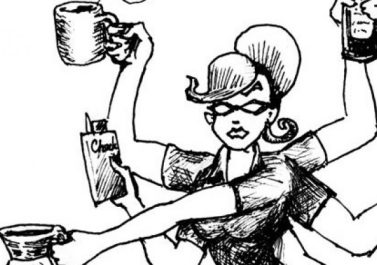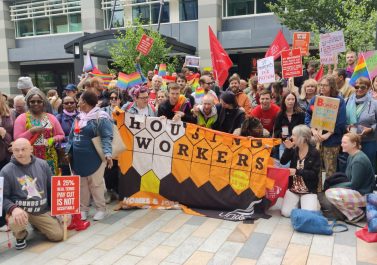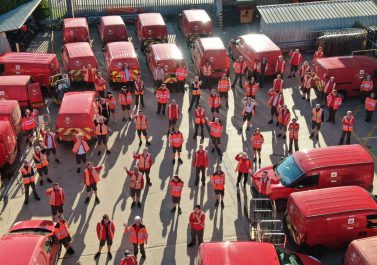“Did you see the HAL lot out Monday? It’s out of order what the company is doing to them. Totally support them. I was called off another job to go over to central and cover in case of emergencies.”
Heathrow contractor.
“I’ve seen communities torn apart when their industries are destroyed overnight. I don’t think people around here realise what’s coming down the tracks, unless we start getting our act together.”
Heathrow worker from South Wales.
On the 1st December, Heathrow Airport Limited (HAL) staff took part in the first of four strikes against the company’s attacks on their pay and conditions. It was great to see workers, in these tough times, in the middle of a pandemic that has hit their industry so severely, willing to stand up to their bosses, take a further hit to their pay packet, and muster the bravery required to go on strike.
It was also heartening to hear some of the reasons they gave. One striker said, “As well as protecting our pay, we’re doing this to try and set an example to the youngsters coming through. They need to see that you don’t just roll over when the company attacks your contract….” Another said, “When the airport sneezes everywhere else catches a cold. Heathrow sets a benchmark for pay and terms and conditions. We have to try and maintain a high standard for workers elsewhere as well….” This is a good example of the sense of purpose and the common good, that often ends up getting people out on strike. We aren’t all the greedy, calculating, money grubbers our bosses would like us to be. Most of us are decent individuals concerned about our wider community. One worker talked about the history of the last strike, which was carried out by engineers to protect the apprenticeship scheme in 1976. A strike with a long-term vision of how to protect their jobs and keep them skilled that has paid off in the long-run. The scheme still exists.
During the 45-day negotiation that followed HAL’s proposed “fire and rehire” program, the company kept moving the goalposts and weren’t budging, even though the union put forward four of their own cost-cutting counter-proposals. In doing so, the union can say, ‘look at us, we’re the reasonable ones here.” This has become commonplace at a time when the right-wing press is so powerful and the unions so demonised that this kind of PR is supposedly necessary to temper it. We would question this approach more generally. The union itself has said that the company is using the pandemic to push through changes that they’ve always intended to make. This is quite clear if we look at the company’s past actions when they’ve tried to make cuts and divide the workforce – all when profits kept on increasing. In the end, we think the union’s counter-proposals to co-manage the cuts have more negative effects than positive ones: the negotiations drag on for longer, the union are seen as co-managers of cuts to T&Cs, the right-wing press will always hate strikers and unions regardless of their attempts to appear like ‘reasonable’ partners at the negotiating table, and the end result is the same anyway.
Strike action has not stopped the imposition of the new contracts (the first strike was held on the 1st December as a symbolic gesture because this was the day the new contracts came into force). In this sense then, the strike has already come too late. The union has to stick to their recognition agreement and jump through all the hoops contained in it to avert a strike, which is why the whole thing takes such a long time. In this situation, the union’s strategy is often to try and use the individual grievance procedure. This is a way to voice their discontent at the same time as overwhelming the HR capacities of the company. However, in this instance, HAL would not recognise the staff’s individual grievances against the imposition of contract changes, insisting instead that it was a collective matter to be dealt with through the union.
It has taken Unite five months to organise a consultative ballot and then a strike ballot, which isn’t too bad in relative terms (no other unions at the airport have even managed this, although for some like PCS, they didn’t get enough support from workers to go ahead). The strike ballot had a 85% return in favour of strike action, which is a swinging mandate. British Airways Cargo staff, also with Unite, balloted much later, so their strikes won’t coincide. Another missed opportunity. A further setback occurred when HAL offered Terminals Security staff, a department with a large chunk of the workforce in it, and whose strike participation really could have shut the airport down, a 5-7% pay increase in an attempt to make sure they didn’t vote to strike. They succeeded. This is an extremely common company tactic to divide workers. This was possibly aided by the fact that, legally, airport security departments have to return a higher amount of votes for them to be allowed to go on strike. The fact that different departments vote to strike as a department, rather than a larger collective bargaining unit, would also be in the recognition agreement, and severely limits the ability of workers to act collectively.
It’s unclear exactly how much disruption the strike caused to the operation at Heathrow. Since the strike, we have spoken with contractors that were called into Heathrow to cover the striking workers. HAL said they had contingency plans in place and this was surely part of it. The contractors are sympathetic to the HAL staff but are not unionised and would be worried about being disciplined if they refused to scab. Given the opportunity, workers could come up with creative solutions to this issue in the short term, but don’t we also need a long-term strategy for how we go about building the kind of unity amongst workers required to make strikes effective?
The problem was highlighted at the pickets themselves. One of the three pickets had reps that were confident in speaking with supporters that arrived to wish them well and ask them questions. The other pickets did not, and one was actively hostile to people coming to offer support. We can only assume that workers on the pickets had been given instructions by the union to not speak with bystanders, to only allow senior reps to talk, or to divert people to the press office. This shows a serious lack of confidence in the union for its members and also for its campaign. What are they worried their members will say, exactly? And why do they think their campaign is so fragile that a conversation at a picket line could in some way derail it?
The pickets also appeared to suffer from issues imposed by the current laws surrounding industrial action. Pickets are to have no more than 6 workers at a time. Looking at the HAL pickets on Dec 1st, with only 6 workers penned off from supporters by steel fences, it was hard not to see them as a bit gloomy. This is also transparently the reason the laws have been written the way they have. There must be ways round this. Around the time of the last BA cabin crew strikes, even though the strikes were still unfortunately largely symbolic, at least the pickets were quite a spectacle. Well attended, extremely noisy, homemade flags, banners, music and dancing. Not sure if these were registered as demonstrations or pickets but there were certainly more than six people there and were all the better for it.
Unite staged a photo opportunity outside the Heathrow Unite offices at which they unveiled a mobile billboard depicting HAL CEO John Holland-Kaye as the grinch. The attendees were mainly press, senior shop stewards and an MP. There was hardly any striking rank-and-file workers present. One woman, whose husband was on strike, was very critical of the union’s strategy, which she called ‘uncoordinated’, and thought more workers from across the airport should be out on strike at the same time. “Where are the workers?”, she complained, to nobody in particular. “And why aren’t unions working together?” She also berated the union for investing all their energies in the media campaign. Union campaigns today do indeed appear to place far too much emphasis on PR – for rather scant media coverage at best, which is not surprising, because it’s not terribly exciting. Photo opportunities and appeals to government are the main levers of the campaign, in place of the main thing that normally “wins” battles like these: mass worker participation in the planning of, and carrying out of, strikes, protests, blockades, sit-ins, marches on the boss etc.
A question workers should also be grappling with is what would/should “winning” look like? At times, not just at Heathrow but everywhere, it seems as though workers are, at best, just managing our own decline. Decline in pay, conditions, skills, control. The pattern regularly goes as follows: bosses make an attack on some aspect of our workplaces; for those lucky enough to work somewhere with a union, the union and some workers make some kind of fuss to show they’re not happy, and then the bosses make a concession that they were probably always more than prepared to make in the first place. And so it goes, from workplace to workplace, up and down the country and across much of the world. Companies are at war with their workers, but the lack of an effective and substantive counter-strategy is glaringly obvious.
We’re not saying that there aren’t any acts of resistance happening in various forms, but that there are still far too few unified and coordinated rank-and-file responses to common problems. Heathrow is chock full of workers faced with similar, if not exactly the same problems. There are countless opportunities for workers to collaborate across unions, companies and professions, yet it rarely happens. Why are workers and their unions so reluctant to work together these days? You would think that the legal barriers in place that are designed to curb workers’ power would force us to try alternative ways of getting around them. The answer is obviously complex and not reducible to this or that workplace or union.
This begs the question: Is the workforce nowadays too divided for unions to have any real teeth? If so, where does this leave us? It will be interesting to see how what has been labelled the new ‘winter of discontent’ will play out in the next few months. There are impending strikes by BT, Rolls Royce, BA and Eddie Stobart. While strikes might be on the increase, this alone won’t be a good indicator of an uptick in workers’ confidence and power. This is why we want to take a closer look at the content of these strikes. How are they being organised? How are workers’ voices and decision-making a part of it? Are there promising tendencies where workers are more in control of their own struggle? If anyone has any insights to share on any upcoming struggle in this regard, please share it. Not to undermine the struggles, but to provide an honest assessment of the situation and where we need to improve. We can be sure that as long as strikes remain hollow shells, as long as they remain isolated within their own companies or departments, and if most workers remain spectators rather than participants in the running of these strikes, the chances of them improving the general situation for the working class is slim.
Any strike to defend our conditions is necessary. If we can manage to control our own struggles, we can ask the question, who controls society. Key workers have managed to pull society through the pandemic – the supermarket shelves were refilled, the sick were cared for, the water and heating kept running. We survived a ‘natural calamity’ and now we are supposed to suffer from a ‘man-made’ one: a crisis in the form of pay and job cuts. How to handle the fallout from this pandemic should be the decision of the workers and the communities affected, not handfuls of rich managers and shareholders. If we took control of our workplaces and the technology and infrastructure that keeps them running, we would make better use of them. We could abolish bullshit jobs and all work much less. We could finally re-organise society in the interest of everyone and future generations. The struggle at Heathrow seems far away from this goal, but it is a small step forward. In the meantime we should say no to job and pay cuts and yes to a reduction of working hours, at the same rate of wages.
Unite’s campaign strategy is that the December strikes are here to show HAL that they have a disgruntled workforce that will be fighting for their pay and benefits back when more planes are in the air and their bargaining position has improved. The anger and momentum will need to be sustained until the aviation situation improves. Something that is tricky to do when there is no immediate impact of the union’s current actions. So where should this momentum come from? We’re interested in finding out how fellow Heathrow workers are supporting these efforts. We want to think about the possibilities of linking this dispute up with other struggles in aviation and beyond. If efforts could be pooled and workers united in greater numbers to resist against the bosses attacks, would we have to wait until more planes are taking off before we “really” start fighting back? We hope our independent Heathrow Workers’ Power newsletter can be a space to think about these kinds of questions. We welcome your contributions! The next three strikes are scheduled for December 14th, 17th and 18th. Up the workers, and see you on the picket lines!
To get involved with our group, share comments, reports and updates, get in contact:-
Email
heathrowworkers@protonmail.com
Twitter
@heathrowworkers
Facebook page
Heathrow Workers Power
Call or Text
07340 082667
And check out our latest newsletter @
https://heathrowworkerspower.wordpress.com/2020/11/27/heathrow-workers-newsletter-no-1/



